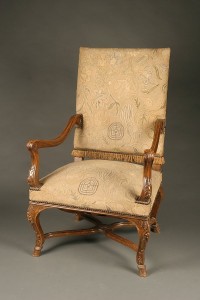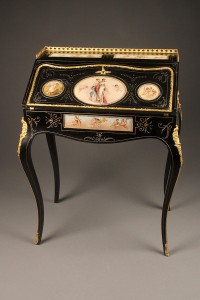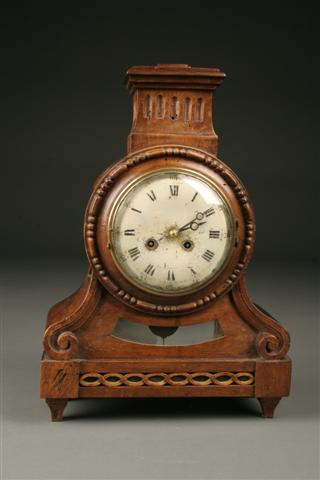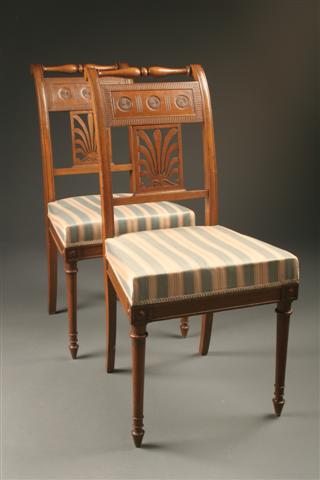Just like today’s furniture and accessories, antiques were crafted with particular styles in mind. In the case of European antiques, these decorative or architectural elements are unique to the time and place in which the characteristics were first crafted. As you peruse Beauchamp’s collection of 18th and 19th century antiques, you will note that some pieces are described by their style, such as Biedermeier era, or English Edwardian period or Louis Phillippe. Though our clients are antique-lovers, we have found that they do not necessarily know the details of each style. Therefore, we thought it would be helpful to offer a retrospective look at the different characteristics of 18th and 19th century antiques through a blog series, Styles of European Antiques.
Our first installment outlines 18th century French antiques:

Louis XIV-Style: 1643-1715
During his reign, King Louis XIV focused on establishing France as a leader in Europe, making the country an economic, political and artistic authority. The furniture of this era reflects many aspects of that ambition. Leaning away from the dramatic Baroque style popular in much of Europe at the time, Louis XIV commissioned artists who had a more classical approach. One such group of craftsmen was the Gobelins manufactory. The furniture they made for the royal court and nobility established a national decorative art style that emphasized grandeur. Furniture was often elaborately gilded with bronze or brass, inlaid with metals such as pewter and ivory, and veneered with tortoise shell or exotic foreign woods. Red and gold brocades, large sculpted sideboards and heavy marbling were also common. Pieces of this period make for rich furnishings, and their grandiose style is perfect for making a statement.

Régence Style: 1715-1723
After the rather heavily adorned style of Louis XIV, a new fashion emerged that pushed back against grandeur and opted for lighter elements. The Régence Style was the beginning of French Rococo, transitioning between the large, heavy pieces made for Louis XIV’s court to easily movable furniture made for smaller rooms. No heavy, carved ornamentation here—the point was to showcase a piece’s graceful craftsmanship. Furniture in this style has many gentle curves, natural patterns and motifs like foliage, bouquets, ribbons and bows. Curved ornamental mounts for chairs and table legs called “espagnolettes” are characteristic of this period, and it is interesting to note that the commode and the writing table made their first appearances during this time, due to the fact that furniture was being made for smaller, more intimate settings.
 Louis XV (Louis Quinze): 1723-1774
Louis XV (Louis Quinze): 1723-1774
A subset of French Rococo, Louis XV-style is characterized by superior craftsmanship. The superb carving, ornamentation with many different metals, inlaid woods, and lacquered chinoiserie, besides showing off the craftsman’s skill, also revealed the new movement to coordinate furniture with the rest of home décor. Painters, sculptors, and cabinet-makers all worked together to create the whole ensemble of a room for royalty and the nobility. Furniture was made to be both elegant and useful. Many homes had two complete sets of furniture: one for summer, one for winter. Decorative elements still stayed with the curves and natural elements of the Régence Style, but added more themes including painting scenes of Orientalia, frolicking animals, and exotic landscapes. Rare woods like tulip, lemon tree, violet and king woods were used, to sumptuous effect. Richly veined, tinted marbles were imported for decoration as well.

Louis XVI (Louis Seize): 1774-1793
The last phase of Rococo for France before the Revolution, Louis XVI-style also began the first phase of Neoclassicism. This style in turn was a revolt against the airy, frivolous Rococo. Furniture was made with emphasis on straight lines, right angles and logical design. Roman and Greek architecture and furniture was the main influence on this style—even incorporating fluted columns into designs. Decoration was restrained, but details were still delicate. Carved friezes, oak and laurel leafs, wreaths, branches, cherubs and lattice work are the motifs of this time. In the areas of craftsmanship and refinement, this was the golden age of French furniture.

Directoire Style: 1795-1799
Continuing the Neoclassical style from Louis XVI, post-revolution. The Directoire was actually the name of the French Revolutionary government, which would yield to Napoleon Bonaparte’s dictatorship. Directoire Style is the artistic transition from Louis XVI to the Empire Style. Furniture continued along the Roman and Greek vein, reflecting stoic values, drawing on examples from the excavations of Pompeii and other ancient cities in Italy. Furniture was elongated, crafted in simple shapes and clear lines. Detail and ornamentation became sparse: there was minimal carving, though they applied decorative painting.
Questions about the different 18th century French antique styles? Send us an email, or give us a call at 1-800-860-0109.
